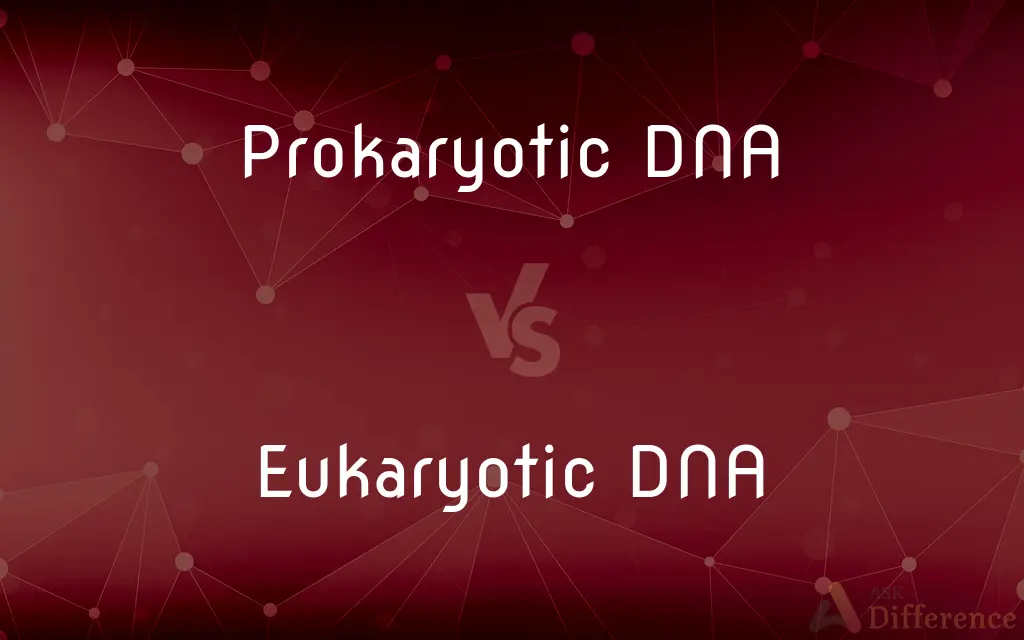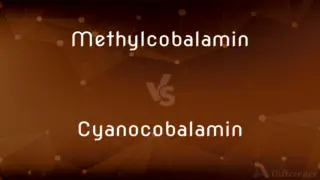Prokaryotic DNA vs. Eukaryotic DNA — What's the Difference?
By Tayyaba Rehman & Urooj Arif — Published on July 14, 2024
Prokaryotic DNA is circular and found in the cytoplasm, lacking histones, whereas eukaryotic DNA is linear, located in the nucleus, and wrapped around histones.

Difference Between Prokaryotic DNA and Eukaryotic DNA
Table of Contents
ADVERTISEMENT
Key Differences
Prokaryotic DNA is typically found in a singular, circular chromosome within the cell's cytoplasm, reflecting its simpler organizational structure. Eukaryotic cells, however, house their DNA in a well-defined nucleus, with the genetic material organized into multiple linear chromosomes.
In prokaryotes, the DNA is not associated with histones, which are proteins that help package and order the DNA into structural units. Eukaryotic DNA, on the other hand, is tightly wrapped around histones, forming a complex called chromatin, which helps in organizing the DNA and controlling gene expression.
Another key difference is the presence of non-coding DNA in eukaryotes, which can make up a large portion of their genome, serving regulatory functions among others. Prokaryotic DNA is more streamlined, with less non-coding DNA and a higher proportion of gene-coding sequences.
Eukaryotic genomes often contain multiple copies of genes, known as gene families, which can lead to a greater complexity in gene expression and regulation. Prokaryotic organisms typically have fewer genes, which are more singular in function and less likely to be duplicated.
Eukaryotic DNA undergoes a process of replication that is more complex and involves multiple origins of replication. Prokaryotic DNA replication begins at a single point and proceeds in two opposite directions until the entire chromosome is copied.
ADVERTISEMENT
Comparison Chart
Location
Cytoplasm
Nucleus
Shape
Circular
Linear
Association with Histones
No
Yes
Amount of Non-Coding DNA
Less
More
Replication
Single origin, bidirectional
Multiple origins, complex
Compare with Definitions
Prokaryotic DNA
Prokaryotic DNA is highly efficient, with most of its sequence coding for proteins.
In prokaryotic DNA, genes are closely packed with little non-coding DNA.
Eukaryotic DNA
Eukaryotic DNA contains a significant amount of non-coding DNA with regulatory roles.
Introns within eukaryotic DNA are non-coding sequences that are spliced out of mRNA.
Prokaryotic DNA
Replication of prokaryotic DNA starts from a single origin and proceeds bidirectionally.
The replication of prokaryotic DNA ensures quick division and proliferation of bacteria.
Eukaryotic DNA
Replication of eukaryotic DNA involves multiple origins to manage its complexity.
The replication of human DNA starts at numerous points to ensure completeness.
Prokaryotic DNA
It lacks histones and other complex packaging structures.
Prokaryotic DNA's simplicity aids in its rapid replication process.
Eukaryotic DNA
Eukaryotic DNA is found in the nucleus of eukaryotic cells, organized into chromosomes.
Human cells contain 46 linear chromosomes made of eukaryotic DNA.
Prokaryotic DNA
It often contains plasmids, which are small, circular DNA molecules that can confer advantageous traits.
Antibiotic resistance in bacteria is often due to genes carried on plasmids within their prokaryotic DNA.
Eukaryotic DNA
It is associated with histones to form chromatin, aiding in DNA packaging and regulation.
Chromatin structure allows eukaryotic DNA to fit inside the nucleus.
Prokaryotic DNA
Prokaryotic DNA refers to the genetic material found in prokaryotes, which is circular and not enclosed in a nucleus.
The E. coli bacterium contains a single, circular chromosome of prokaryotic DNA.
Eukaryotic DNA
Gene duplication and families are more common, contributing to genetic diversity.
The presence of multiple olfactory receptor genes in eukaryotic DNA allows for a broad range of smells to be detected.
Common Curiosities
Can prokaryotic organisms contain eukaryotic DNA?
No, prokaryotic organisms contain prokaryotic DNA, which is distinct in structure and organization from eukaryotic DNA.
What role does non-coding DNA play in eukaryotes compared to prokaryotes?
Non-coding DNA in eukaryotes often has regulatory roles and makes up a larger portion of the genome, whereas prokaryotic DNA has less non-coding DNA and is more streamlined for coding genes.
Do both prokaryotic and eukaryotic DNA contain histones?
No, prokaryotic DNA does not contain histones, whereas eukaryotic DNA is associated with histones.
How does the replication process differ between prokaryotic and eukaryotic DNA?
Prokaryotic DNA replication starts from a single origin and is bidirectional, while eukaryotic DNA replication involves multiple origins and is more complex.
What is the main structural difference between prokaryotic and eukaryotic DNA?
Prokaryotic DNA is circular and found in the cytoplasm, while eukaryotic DNA is linear and contained within the nucleus.
How does the cellular location of DNA differ between prokaryotes and eukaryotes?
In prokaryotes, DNA is located in the cytoplasm, whereas in eukaryotes, it is contained within the nucleus.
How does the presence of introns in eukaryotic DNA affect gene expression?
Introns, which are non-coding sequences, are spliced out of mRNA before translation, affecting gene expression and allowing for alternative splicing in eukaryotic DNA.
Are plasmids found in eukaryotic DNA?
Plasmids are primarily associated with prokaryotic organisms, though some eukaryotic cells, like yeast, can also contain plasmids.
What is the significance of histones in eukaryotic DNA?
Histones help package and organize eukaryotic DNA into chromatin, playing a crucial role in gene regulation and DNA repair.
Is gene duplication more common in prokaryotic or eukaryotic DNA?
Gene duplication is more common in eukaryotic DNA, contributing to greater genetic complexity and diversity.
Share Your Discovery

Previous Comparison
Methylcobalamin vs. Cyanocobalamin
Next Comparison
Treadmill vs. Walking PadAuthor Spotlight
Written by
Tayyaba RehmanTayyaba Rehman is a distinguished writer, currently serving as a primary contributor to askdifference.com. As a researcher in semantics and etymology, Tayyaba's passion for the complexity of languages and their distinctions has found a perfect home on the platform. Tayyaba delves into the intricacies of language, distinguishing between commonly confused words and phrases, thereby providing clarity for readers worldwide.
Co-written by
Urooj ArifUrooj is a skilled content writer at Ask Difference, known for her exceptional ability to simplify complex topics into engaging and informative content. With a passion for research and a flair for clear, concise writing, she consistently delivers articles that resonate with our diverse audience.














































